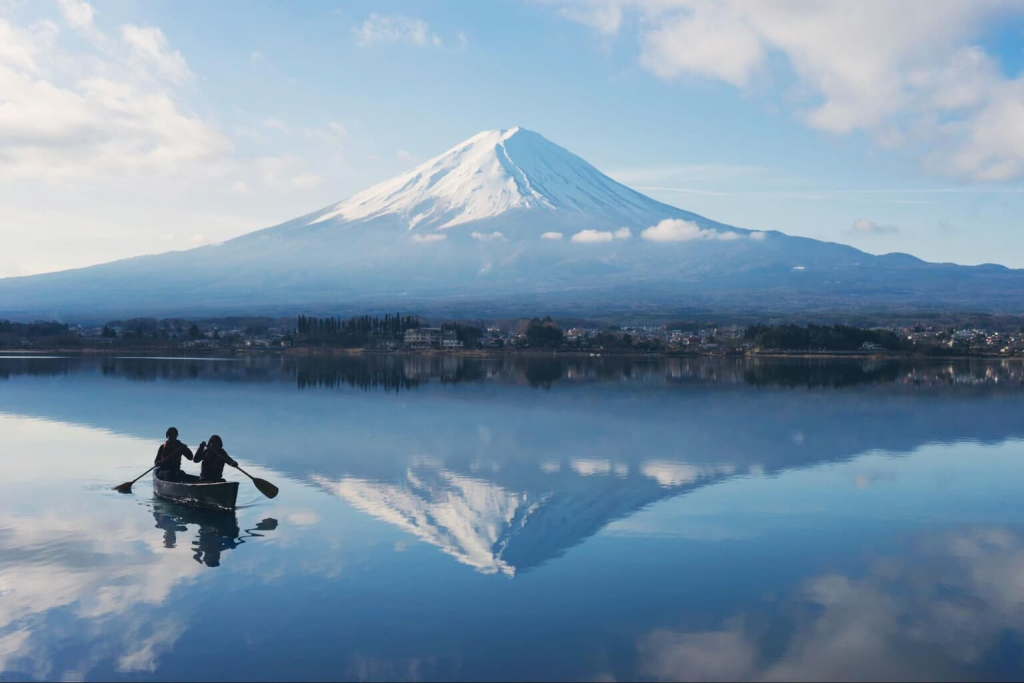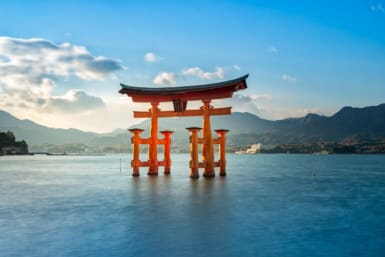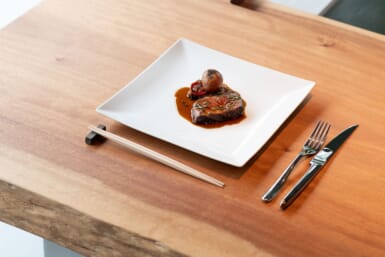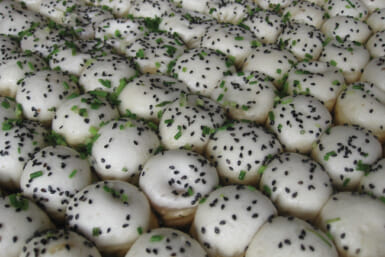The regional culture of Yamanashi Prefecture deeply intersects with nature. Home to the northern part of Mount Fuji — which also straddles Shizuoka Prefecture — it welcomes thousands of hikers and ascetic pilgrims every year, who climb to the zenith of Japan’s most famous spiritual peak. The waters of nearby Lake Kawaguchiko lure canoeists and kayakers, while the surrounding shores are popular haunts for crack-of-dawn yoga enthusiasts. Furthermore, the local terroir has ensured Yamanashi is Japan’s premier wine-producing region, so there are plenty of local tipples to enjoy after a day immersed in the great outdoors.
Read on for our top Yamanashi travel recommendations.

1. Canoe at Sunset on Lake Kawaguchiko
Though Japan is often referred to by its moniker, “The Land of the Rising Sun”, its sunsets can inspire equal amounts of awe. There are few better ways to take in the soothing pastels of the sun flattening over the horizon than from the tranquil waters of Lake Kawaguchiko, which sits near the foot of Mount Fuji.
Under the tutelage of a local guide, guests can paddle across the mirror-esque lake in canoes or kayaks as dusk settles upon the land. The 90-minute tours are typically conducted in small groups, allowing each individual to navigate the lake at their own pace and to freely communicate with the English-speaking guides.

2. Tap Into Your Spiritual Side
Given Japan’s deep-seated connection to Zen Buddhism, yoga has long been a popular pastime. If you want to embark upon your own spiritual journey to nirvana, or simply start the day free of digital stimuli, consider an hour of yoga by the Kawaguchiko lakeside.
The up-to-10-people classes by Nipa Yoga, with the 7am option recommended for early risers. Allow the crisp morning air, the trilling sounds of nature and the clam, controlled movements of your yoga routine to facilitate a state of mindfulness.
For more adventurous types, a yoga session can act as a prelude to trekking through the dense forest at the foot of Mount Fuji. The two-hour hiking course is akin to strenuous shinrin-yoku, or “forest bathing,” a form of motive mediation whereby mindfulness is achieved through moving within and feeling a connection to the natural world.
As shinrin-yoku has grown in popularity, its practitioners have sought to scientifically prove its benefits. We now know that when humans breathe in phytoncides – organic compounds emitted by plants – they boost our immune system, have relaxing effects on the central nervous system, reduce stress hormones, and improve liver function.

3. Board in Boutique Accommodations
Even in Yamanashi Prefecture, you can find high-end accommodations to suit your tastes and preferences. Among the most unique lodging facilities around Lake Kawaguchiko is a boutique glamping resort run by Japanese hotel giant Hoshino Resorts constructed in a sloping pine forest overlooking the water.
Hoshinoya Fuji combines the romantic aspects of a camping trip – the sense of exploration, raconteuring by the campfire, waking up to the scent of coniferous forests – with luxurious hotel facilities. Cabins built in the in-vogue style of concrete minimalism are scattered among the pine trunks and cherry blossom trees, each with a viewing terrace that looks to Mount Fuji. The resort’s French-inspired dining fare features game, such as deer and wild boar, caught by local hunters and served alongside seasonal woodland fruits and vegetables. Canoeing trips, food smoking experiences and nature tours are also available. For more information, consult the hotel staff.

If you’d prefer a more traditional luxury hotel, Kukuna Kawaguchiko is your best bet. Each room at the resort and spa has a balcony that casts its eye towards Mount Fuji, while the Terrace Lounge and Bar features a wine dispensary and in-house sommelier to guide you through the menu. Kukuna Kawaguchiko also has a “sky onsen” on its top floor and a Japanese-Western fusion restaurant that takes diners on a culinary journey through the seasons.

4. Slurp on Hoto Noodles and Sip on Koshu Wine
Every prefecture in Japan has a meibutsu, literally “famous thing”, and in Yamanashi, this term can accurately be applied to hoto noodles and koshu wine.
Hoto noodles, made by kneading wheat flour and slicing it into flat pieces, is a favored dish in the prefecture. It’s said that the aristocrats of the Heian Period (794–1185) enjoyed hoto noodles during ceremonies and other celebrations.
The noodles are served in a thick soup, perfect for warming diners’ bones during the chilly winters, alongside meat, mushrooms and seasonal vegetables. To sample the dish which was officially anointed one of the “Top 100 Local Cuisines of Rural Villages” in 2007, head to Hoto Fudou, which has several branches in the Kawaguchiko area.
Yamanashi is Japan’s most famous wine region, with the highest production volume and number of wineries in the country: 85, according to National Tax Agency statistics in 2019. The wineries are concentrated around the Kofu Basin, where relatively little rainfall, long hours of sunshine and ideal soil conditions are well suited to cultivating grape trees. Many of the wineries are open to guests, with tasting menus that can be sampled on terraces overlooking the surrounding vineyards.
One of the most popular grapes, koshu, which is also native to Japan, has been cultivated since the Edo Period (1603–1868). The wine’s unique astringent taste has earned it national acclaim, and overseas sommeliers are starting to take notice, too. Check out the local varieties of koshu wine, or visit one of the many wineries that specialize in the grape.
Sponsored Post
Updated On January 17, 2023









